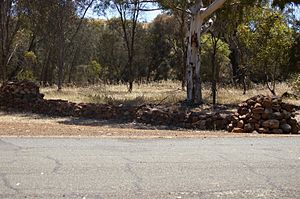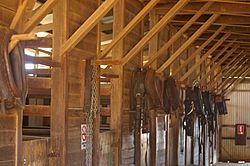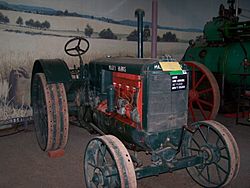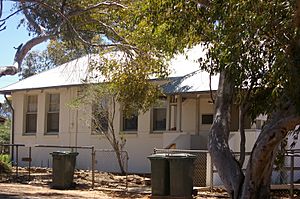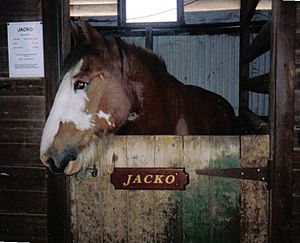Avondale Agricultural Research Station facts for kids
Quick facts for kids Avondale Agricultural Research Station |
|
|---|---|
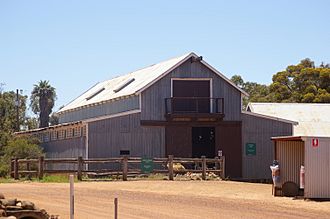
The heritage-listed stables were built around 1890.
|
|
| General information | |
| Type | Research Station |
| Location | Beverley, Western Australia |
| Coordinates | 32°7′00″S 116°52′07.9″E / 32.11667°S 116.868861°E |
| Designated | 19 March 2004 |
| Reference no. | 5566 |
The Avondale Agricultural Research Station, also known as Avondale Discovery Farm, is a special farm in Western Australia. It is one of thirteen research stations run by the state's Department of Agriculture and Food.
Avondale is more than just a place for science. It has historic buildings, a museum full of old farming equipment, and an education center. It's a popular spot for primary school students to learn about farming and its history in Western Australia.
The farm is located where the Dale River and the Avon River meet, near the town of Beverley. The land was first given to two important figures in the colony's history: Governor James Stirling and Captain Mark Currie in 1836. Over time, these pieces of land were joined together to create the large Avondale Estate.
In 1924, the farm was given to the Department of Agriculture. At first, it helped new farmers get started. But by 1926, it became a center for important research. In the 1930s, a scientist named Dr. Harold Bennetts made a major breakthrough here, finding a cure for a serious sheep disease.
Today, the National Trust of Western Australia manages Avondale. It is open to the public at different times of the year, so people can visit and learn about its amazing history.
Contents
The Early Years of the Farm
In 1835, Governor James Stirling led an expedition through the area. They were mapping a new route to connect the settlements of King George Sound, York, and the Swan River Colony. During this trip, they saw a granite hill that was named Bald Hill. This hill became a key landmark for surveying, or mapping, the land.
A year later, a surveyor named Thomas Watson used Bald Hill to map out large plots of land. Two of these plots were given to Governor Stirling and Captain Mark Currie as payment for their work in the new colony. Even 142 years later, modern surveyors were impressed by how accurate Watson's original maps were.
Creating the Avondale Estate
In 1838, Captain Currie sold his land to a man named Nicholas Carey. A few years later, Carey also made a deal to buy Governor Stirling's land. He bought more land nearby, and by 1849, he owned a huge property of over 13,330 acres (53.9 km2). He named it the Avondale Estate.
When Carey died in 1889, his grand-nephew, William Herbert deLisle, inherited the farm. When deLisle arrived in 1893, he began to develop the property. He sold off parts of the land to pay for improvements, like expanding the main house and building large stables. The stables were cleverly designed with 20 stalls that had hollow walls. This allowed feed from the loft above to slide down directly into the horses' food bins.
In 1904, the rest of the estate was sold to two brothers, William and Charles Butcher. They added more land, making Avondale even bigger. In 1910, they sold the entire property to the Western Australian Government.
A New Plan for Avondale
The government planned to divide Avondale into smaller farms for new settlers. However, the plan didn't go as expected. The land was expensive, and many settlers couldn't afford it. Some who did buy farms, like George Hancock (the father of mining billionaire Lang Hancock), eventually had to abandon them.
For a while, there was a plan to turn Avondale into an Agricultural College, but the start of World War I put a stop to that idea. Later, after the war, some of the land was set aside for returning soldiers from the Beverley area. The main part of the farm, including the homestead, remained under government control.
A Center for Agricultural Science
In 1924, the main homestead block was finally given to the Department of Agriculture. At first, it was used to hold dairy cattle before they were sent to new farmers in the state's south-west. During this time, a 100-tonne silo was built, which is now a heritage-listed structure.
Soon, the farm's focus shifted to growing pure seeds and conducting research. The first experiments began in 1926, studying the best ways to use superphosphate fertilizer on crops.
Solving a Sheep Sickness Mystery
In 1915, a mysterious disease started affecting sheep in the region, causing many to die. For years, no one could figure out the cause. In 1925, a veterinary pathologist (an animal disease expert) named Dr. Harold Bennetts was hired to solve the puzzle.
In 1930, a special laboratory was built for him at Avondale. With a large flock of sheep to study, Bennetts was able to identify the bacteria causing the sickness. By 1931, he had developed a vaccine for infectious enterotoxaemia, saving countless sheep across the state. For his incredible work, he was awarded a CBE, a high honor.
More Groundbreaking Research
The large sheep flocks at Avondale were also used for other important studies.
- Better Lambs: In the 1930s, scientists researched the best sheep breeds for producing high-quality lamb for export.
- Poisonous Plants: In 1934, Dr. Bennetts worked with botanist Charles Gardner to find out which native plants were poisonous to sheep. They identified 24 toxic plant species, which helped farmers protect their animals.
- Animal Nutrition: In the mid-1930s, Dr. Eric Underwood began his research at Avondale. He studied how different foods affected sheep health and wool growth. His work on the nutritional value of hay and pasture was very important for farmers.
During World War II, Avondale also helped with the war effort by researching how to grow flax and linseed in Western Australia.
From Workhorses to Museum Stars
For many years, strong Clydesdale horses did all the heavy work on the farm, like pulling plows. In the 1930s, when a horse became too old to work, it was often given to the Perth Zoo to feed the lions. This was a common practice at the time, before tractors replaced horses on farms.
Today, Clydesdales are back at Avondale, but not for heavy farm work. They are used for demonstrations to show visitors how old farm machinery worked. When these horses retire, they are sold as pets to loving homes.
Avondale Today
In 1976, the government decided to restore Avondale's historic buildings for Western Australia's 150th-anniversary celebration in 1979. Farmers from all over the state donated old machinery, which was carefully restored. On March 16, 1979, Prince Charles officially opened the new agricultural museum at Avondale.
The farm continues to be a place of important research, focusing on sustainable farming and finding new income sources for farmers, like raising marron (a type of freshwater crayfish).
Visitors can explore the original homestead, the stables with their Clydesdales, and a large machinery shed. There is also a driving trail around the farm with signs explaining the research happening in each paddock.
See also
- Agricultural science
- Agriculture


